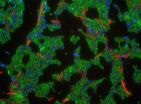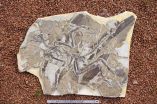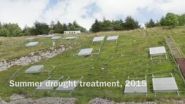(Press-News.org) This news release is available in German.
The yields of many important crops in Europe have been stagnating since the 1990s. As a result, the input of organic matter into the soil - the crucial source for humus formation - is decreasing. Scientists from the Technical University Munich (TUM) suspect that the humus stocks of arable soils are declining due to the influence of climate change. Humus, however, is a key factor for soil functionality, which is why this development poses a threat to agricultural production - and, moreover, in a worldwide context.
In their study, which has been published in Science of the Total Environment (2015), scientists from the Technical University Munich (TUM) evaluated the crop yield statistics for EU countries compiled by the Food and Agriculture Organization of the United Nations (FAO) since the 1960s. The yields for the three most important cereal crops, wheat, barley, and corn, have been stagnating in Central and Northern Europe for 20 years. "The stagnation in yields has only been statistically verifiable for a few years," explains Dr. Martin Wiesmeier from the TUM Chair of Soil Science in Freising-Weihenstephan and first author of the study. This finding coincides with those of other studies, which confirm that crop yields, particularly in the case of cereals, are falling throughout the world.
"Due to the strong link between crop yields and the input of organic substances into the soil, the stagnation in yields must also have an impact on the humus stocks in the soil," says TUM scientist Wiesmeier, "particularly in the context of the steady rise in temperatures." Given that rising temperatures cause higher levels of humus decomposition while, at the same time, the supply of organic substances is stagnating, a depletion of humus must be expected in the long term.
Climate change and changes in EU agricultural policy as possible causes?
The cause of the yield stagnation has not yet been explained but is probably due to a variety of factors: "Following the introduction of new priorities with the joint EU agricultural policy of the 1990s, among other things, less fertilizer was used and leguminous plants were often omitted from crop rotation cycles," explains Wiesmeier's co-author Dr. Rico Hübner from the Chair for Strategic Landscape Planning and Management, also in Weihenstephan. "Few authors have discussed this as a reason for the stagnation in crop yields," he notes.
However, the changes in climatic conditions arising from climate change could represent a far more important factor here: i.e. temperatures that increasingly exceed the optimum level for plant growth, like those experienced this summer, shifts in the vegetation periods, and more frequent droughts. "This inevitably leads to stagnation in crop biomass production and reduced inputs of organic matter into the soil," says Wiesmeier.
Moreover, livestock numbers in Europe have also declined significantly since the 1980s. "The spreading of organic fertilizer, another important source of organic matter, is also falling as a result," adds Wiesmeier.
Early signs of a reduction in humus stocks due to the stagnating harvest yields can already be observed. Initial indications of humus depletion in arable soil have been observed in almost all EU countries in recent years.
Interdisciplinary research group
While many previous studies predicted a future increase in humus levels as a result of climate change, based on their current findings, the TUM scientists are critical of this assumption: If the input of organic matter stagnates, soil will lose some of its humus in the long term. "If this trend continues, it could have negative impacts on soil fertility and water storage capacity," concludes TUM scientist Wiesmeier. "This, in turn, could ultimately result in poorer harvests - a vicious circle," he adds.
To counteract the problem, agriculture needs to make far greater use of positive measures for the promotion of humus formation. "These include the diversification of crop rotation, the application of green manure and winter greening to reduce soil erosion, optimized soil cultivation, organic farming, agroforestry, and leaving crop residues on fields," explains Hübner. The study authors also consider that interdisciplinary research on the causes of yield stagnation and humus depletion is essential, "as a single discipline alone cannot solve this problem."
INFORMATION:
publication:
Martin Wiesmeier, Rico Huebner, Ingrid Koegel-Knabner: Stagnating crop yields: An overlooked risk for the carbon balance of agricultural soils, Science of the Total Environment, August 2015. doi:10.1016/j.scitotenv.2015.07.064
http://www.sciencedirect.com/science/article/pii/S0048969715304071
contact:
Dr. Martin Wiesmeier
Technical University of Munich
Tel.: +49 8161 71 -3679
wiesmeier@wzw.tum.de
http://www.soil-science.com
Young adults diagnosed with attention deficit/hyperactivity disorder (ADHD) in adolescence show differences in brain structure and perform poorly in memory tests compared to their peers, according to new research from the University of Cambridge, UK, and the University of Oulu, Finland.
The findings, published today in the journal European Child Adolescent Psychiatry, suggest that aspects of ADHD may persist into adulthood, even when current diagnostic criteria fail to identify the disorder.
ADHD is a disorder characterised by short attention span, restlessness and ...
This news release is available in French and Portuguese. Health providers trained to perform malaria rapid diagnostic tests (RDT) are still prescribing valuable malaria medicines to patients who do not have malaria, according to new research published in PLOS ONE.
Almost 5,000 participants from 40 communities took part in the study, at a variety of public health facilities, pharmacies and drug stores in the Nigerian state of Enugu. Despite the three different training interventions that they received and their satisfaction with the courses and materials, rates of ...
A study conducted with experienced scholars of Zen-Meditation shows that mental focussing can induce learning mechanisms, similar to physical training. Researchers at the Ruhr-University Bochum and the Ludwig-Maximilians-University München discovered this phenomenon during a scientifically monitored meditation retreat. The journal Scientific Reports, from the makers of Nature, has now published their new findings on the plasticity of the brain.
Participants of the study use a special meditation technique
The participants were all Zen-scholars with many years of ...
Researchers led by the UCLA Fielding School of Public Health examined HIV testing trends among adults ages 50 through 64 both before and after 2006, when the Centers for Disease Control and Prevention (CDC) recommended that most doctors automatically screen all patients for HIV regardless of whether they have symptoms.
The researchers found that gains in HIV testing were not sustained over time. Levels of engagement in HIV risk behaviors remained constant, yet testing decreased among this age group from 5.5 percent in 2003 to 3.6 percent in 2006. It increased immediately ...
It's bacteria against bacteria, and one of them is going down.
Two UC Santa Barbara graduate students have demonstrated how certain microbes exploit proteins in nearby bacteria to deliver toxins and kill them. The mechanisms behind this bacterial warfare, the researchers suggest, could be harnessed to target pathogenic bacteria. Their findings appear in the Proceedings of the National Academy of Sciences.
Lead authors Julia L.E. Willett and Grant C. Gucinski have detailed how gram-negative bacteria use contact-dependent growth inhibition (CDI) systems to infiltrate ...
Some children react more strongly to negative experiences than others. Researchers from the Norwegian University of Science and Technology (NTNU) have found a link between aggression and variants of a particular gene.
But children who react most aggressively also tend to respond more strongly to good experiences, the Norwegian researchers found. These children's mood swings have deeper valleys, but also greater peaks.
Aggression is common in young children. Aggressive behaviour increases until children are around 4 years old, and then gradually subsides.
Research ...
PROVIDENCE, R.I. [Brown University] -- A study provides multiple lines of new evidence that pigments and the microbodies that produce them can remain evident in a dinosaur fossil. In the journal Scientific Reports, an international team of paleontologists correlates the distinct chemical signature of animal pigment with physical evidence of melanosome organelles in the fossilized feathers of Anchiornis huxleyi, a bird-like dinosaur that died about 150 million years ago in China.
The idea that melanosomes, which produce melanin pigment, are preserved in fossils has been ...
Physicists have found a radical new way confine electromagnetic energy without it leaking away, akin to throwing a pebble into a pond with no splash.
The theory could have broad ranging applications from explaining dark matter to combating energy losses in future technologies.
However, it appears to contradict a fundamental tenet of electrodynamics, that accelerated charges create electromagnetic radiation, said lead researcher Dr Andrey Miroshnichenko from The Australian National University (ANU).
"This problem has puzzled many people. It took us a year to get this ...
COLUMBUS, Ohio - Many clinical trials use genome sequencing to learn which gene mutations are present in a patient's tumor cells. The question is important because targeting the right mutations with the right drugs can stop cancer in its tracks. But it can be difficult to determine whether there is evidence in the medical literature that particular mutations might drive cancer growth and could be targeted by therapy, and which mutations are of no consequence.
To help molecular pathologists, laboratory directors, bioinformaticians and oncologists identify key mutations ...
A study by the University of Liverpool has found that the genetic diversity of wild plant species could be altered rapidly by anthropogenic climate change.
Scientists studied the genetic responses of different wild plant species, located in a natural grassland ecosystem near Buxton, to a variety of simulated climate change treatments--including drought, watering, and warming--over a 15-year period.
Analysis of DNA markers in the plants revealed that the climate change treatments had altered the genetic composition of the plant populations. The results also indicated a ...



